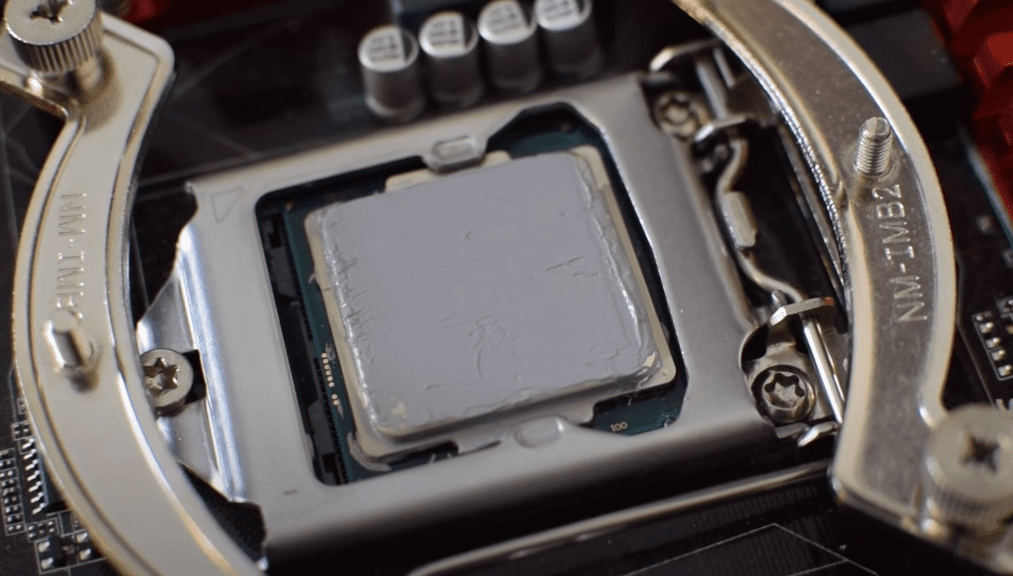What We Have Covered in This Article
Last Updated on October 3, 2022 by Editor Futurescope
Modern PCs are powerfully-built, but they contain sensitive electronic components vital for great performance. Overheating may be an issue if you heavily use the microprocessor and other parts. You may use the thermal paste to resolve the issue, but you may wonder if the thermal paste causes overheating.
The thermal paste may or may not cause overheating. The primary function of the thermal paste is to drive heat away from the PC chips. However, too much paste may act as an insulator, causing components to overheat.
Keep reading this article to learn the steps to follow when using and applying thermal paste and other exciting facts about thermal paste.
Thermal Paste: What it is and its importance
Thermal paste is a substance used when installing any cooling solution. In the world of PCs, it is for installing a CPU cooler. Sometimes, it’s used as an aftermarket cooling solution for a graphic card.
A computer CPU can overheat when overworked and not allowed to rest. At high temperatures of about 1000C, the CPU will start to throttle, causing freezing of the system.
However, CPUs must have a cooling solution, such as a fan or a liquid coolant, to chill the heat sink that removes the CPU’s thermal energy. Despite your cooler, you’ll need to join it to the processor through a cold plate made of copper or aluminum.
The plate absorbs heat from the CPU’s built-in heat spreader. The CPU base and the heat spreader look smooth but aren’t perfect, and thus prevent contact between the two surfaces.
Tiny microscopic bubbles usually get trapped between the two surfaces, and the air is a poor heat conductor.
The paste acts as a liquid medium for insulating the interface area and filling the air gaps. After application, there’s minimal thermal resistance, and the temperature range of the CPU is maintained.
4 Things to Know Before Applying Thermal Paste
When you want to apply thermal paste, there are things you need to consider to increase product efficiency and proper heat release.
Clean First
A clean work area is crucial as it is good to lay both thermal faces facing up. Use dry paper or cloth to wipe the loose debris.
Both surfaces are wipeable using alcohol, but ensure it dries completely. You can use alcohol to remove the old thermal paste from your components.
Old thermal paste shouldn’t be put back into use, so after separating the heatsink, ensure you clean all old material thoroughly. Finally, apply the new thermal paste before re-attaching.
Ensure you have a clear surface
Underestimating proper cleaning of both surfaces from oil, dirt, and debris may interfere with the cooling performance.
All labels and stickers require removal. The lack of a transparent surface might not guarantee proper heat dissipation.
Use minimal thermal paste.
Depending on the paste quality, it may act as an insulator when you apply excess thermal paste. It may make the paste ineffective or damage the components due to overheating.
Put a thin layer of paste on the component. The purpose of the thermal paste is to fill in the small gaps between the two surfaces. Properly installed paste guarantees an effective transfer of thermal energy.
Use quality thermal paste.
Using low-quality thermal paste on your expensive equipment may have adverse effects. Use quality thermal paste such as ShinEtsu’s X23-7783D to enjoy zero curing time, faster processor speeds, and prolonged life of components.
Can Bad or Dried Thermal Paste Cause Overheating?
People who build or modify their PCs commonly use thermal paste. Many people may not know what bad thermal paste may do to computer components.
The primary function of the thermal paste is to siphon heat away from chips in PCs and gaming consoles. These devices build up a lot of heat as they execute their functions.
The dryness may hinder proper heat transfer if the thermal paste dries excessively. In case this happens, the distortion of cooling chips may occur.
In rare cases where the dry or bad thermal paste fails to siphon heat, a heat build-up is evident in the chips. However, dry thermal paste doesn’t cause much overheating that may hinder performance.
When the thermal paste fails to work, your PC can crank up the internal fan to increase the much-needed cooling.
Many modern devices have automatic shutoffs that turn off in case excess heat is detected. It’s imperative to note that dried thermal paste doesn’t cause any computerized problems.
Can a New Thermal Paste Fix Overheating?
Check the state of the thermal paste when you notice your CPU is overheating. Many manufacturers claim that their paste has a 3-5 years lifespan. However, they may not last that long.
Check your PC’s heat build-up if you’ve not changed your thermal paste within three years. If your computer runs close to 850C when playing games, consider changing the thermal paste soon.
Buy a high-quality thermal paste to prevent overheating, which may cause your computer to get damaged.
Do I Need To Replace Thermal Paste After Removing the Heatsink?
This replacement depends on several things:
- Whether the thermal paste was new when you removed or returned the heatsink
If yes, there’s no need to replace the existing one by applying for a new one.
- Did the thermal paste get distorted when removing or refitting the heatsink?
If this happens, you may go for a new paste application. However, this depends on the damage caused during the heatsink removal.
Playing it safe and replacing existing paste with a new layer is no problem. This replacement is essential if you plan on overworking your device after rebooting.
Always conduct regular maintenance checks on your device to ensure proper functioning. If the performance is low, consider using a new thermal paste for effective cooling.
What Happens If You Don’t Reapply Thermal Paste?
If you use your PC with high settings, a lack of thermal paste can cause overheating risks, eventually leading the computer to shut down for protection.
The thermal paste may be unnecessary if you always use your computer at minimal levels. You’ll need to use your computer at high power sometimes. Therefore, skipping reapplying thermal paste isn’t advisable.
No thermal paste implies more air bubbles between CPU and heatsink, causing poor functioning of your device. Additionally, heat dissipation won’t be effective.
How Often Should I Apply New Thermal Paste?
Drying the thermal paste over time may cause your device to be less effective. Therefore, it’s a good idea to reapply thermal paste regularly.
Quality thermal paste should last several years. When it’s new, it should last for three to five years. Due to the long-lasting nature of the paste, reapplying thermal paste often can’t improve your computer’s performance.
When you are doing proper cleaning of the CPUs cooler, you may change the thermal paste. If you notice performance decline or overheating, you should reapply more thermal paste.
How Long Does Thermal Paste Last Once Applied?
Many people feel comfortable using thermal paste for a minimum of five years. However, the general climate, your PC’s cooling system, and the quality of paste you buy will make the difference.
Use the thermal paste recommended for your computer. You may choose to buy other pastes but using the recommended one is vital for increased performance.
The durability of your paste may decline due to overclocking your PC or constantly playing games. The texture will tell you whether you need a new paste or not.
How Much Thermal Paste is Enough?
When this question arises to CPU and GPU manufacturers, they simply answer ‘not too much. This answer isn’t helpful. AMD and Intel manufacturers prioritize using thermal paste the size of a grain.
You may see this portion as little and think it might not cover the whole surface well. It’s important to note that too much paste doesn’t guarantee less overheating and may cause more harm.
Thick paste prevents the surfaces from connecting and will act as an insulator, making the paste ineffective.
Another issue you may encounter is when you use excess thermal paste that moves out beyond the chip and plate. When there’s an invasion of the CPU, unwanted heat transfer may be moving to electrical contacts causing damage.
5 Steps to Fix Too Much Thermal Paste
Have you applied excess thermal paste and wondered what to do? Follow these steps to fix the issue:
Step 1: Removing the CPU cooler
If the CPU cooler you have installed has too much thermal paste, the first thing is to remove it. If you haven’t installed it, move to the second step.
Step 2: Cleaning the Paste Off
If you’ve let the paste solidify, you’ll require a flat-end spudger to remove it from the heatsink surface. However, be careful and gentle without using any metal objects.
Use a coffee filter or cotton swab dipped in isopropyl alcohol to remove any remaining residue on the heatsink. Use the cotton swab gently and clean the remaining paste on the heatsink.
If the thermal paste is still liquid, using a cloth with alcohol is recommended, and be cautious not to get more paste on other parts.
Once done, allow the alcohol to dry. Use paper to wipe dust accumulated on the surface.
Step 3: Preparation
Constant heating of your PC may imply that you need to use a new thermal paste. Therefore, here are the points to note when purchasing a thermal paste:
- Density- Thermal paste is essential for proper application and spreading on the heatsink surface. Liquid paste with lower density is harder to apply than regular.
- Viscosity- The higher the viscosity, the better it sticks to your CPU cooler.
- Thermal Conductivity- Thermal conductivity rating may show how effectively the thermal paste you chose cools your heatsink. Liquid thermal paste has a conductivity of 70W/ mK, while non-metallic has 410W/ mK.
- Conductivity- Some pastes should be applied with caution because leakages to the motherboard may cause short circuits. Carbon-based compounds that don’t conduct are an ideal choice.
- Paste type- There are four pastes: metal, silicon, ceramic, and carbon-based.
Metal pastes conduct electricity but are the most effective heat conductors. They are best for PC gamers and those who run their computers non-stop. Ceramic pastes aren’t conductive and are easy to apply. Silicone pastes come pre-applied to thermal pads that you place between processor and heatsink.
Step 4: Application
There are different application methods developed over the years by PC lovers. Let’s look at some of them and then choose your ideal one:
- Small dot at the center:
The dot indicates that you put a pea-size of thermal paste at the center of the surface, which shouldn’t be bigger than the surface diameter. This method minimizes the chance of spilling the thermal paste.
- A thin spread:
You must wear latex gloves as you’ll use your fingers. There will be even coverage and maximum contact between the heatsink and cold plate. It may lead to the formation of air pockets. For this method, use a paste with a medium thickness.
- A cross:
You can also choose to draw a cross shape with the paste, ensuring the lines aren’t too thick. This method allows the paste to reach the corners of the heatsink better.
- Two parallel lines:
Draw two parallel lines with the thermal paste, which should be a third of the processor’s width.
Step 5: Result Checking
Check your application process to ensure no thermal paste spills over the CPU’s or motherboard’s edges. You’ve done great work if the cooler doesn’t move when you touch it.
Final thoughts
Thermal paste is a fantastic product if you use it properly. It can’t fix the internal problems of your PC, but it can assist you in avoiding them by reducing overheating. Ensure you use quality thermal paste and apply it correctly.









